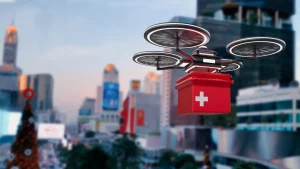
Researchers from the Karolinska Institutet have been studying the concept of drones fitted with Automated External Defibrillators (AEDs) for emergency cardiac arrest patients, rather than sending only an ambulance. They discovered that in over 50% of the cases, the drones beat the ambulances by a total time of three minutes. They also found that most of the time, the AED drones were used to stop the condition from further deteriorating or resulting in death.
‘The use of an AED is the single most important factor in saving lives. We have been deploying drones equipped with AED since the summer of 2020 and show in this follow-up study that drones can arrive at the scene before an ambulance by several minutes. This lead time meant that the AED could be used by people at the scene in several cases,’ explained Andreas Claesson, principal investigator of the study and Associate Professor at the Center for Cardiac Arrest Research at the Karolinska Institutet.
Cardiac arrest is a medical condition where the heart stops beating suddenly as a result of a heart attack, irregular heartbeats, or any other cardiac disorder. It is potentially fatal and immediate intervention is required to preserve the patient’s life.
Defibrillators are one of the most important innovations for cardiac arrest. Defibrillation refers to a medical procedure where a therapeutic and carefully measured dose of electrical energy is sent to the heart with the aim of restoring the regular cardiac rhythm. AEDs are regularly used for this in hospital settings and other public places. Consequently, their prompt arrival at the location of the patient is key.
Karolinska Institutet has been working on the dispatch of drones fitted with AEDs alongside ambulances for over three years now. This project was done in collaboration with SOS Alarm, Region Västra Götaland, and Everdrone. The study was conducted using about 200,000 people in Sweden. The initial research results showed that the concept was safe and feasible.
In the study, drones were dispatched with AEDs in 55 cases of cardiac arrest. In 37 of those cases amounting to about 67%, it arrived before the ambulance with a lead of three minutes and fourteen seconds.
‘Our study now shows once and for all that it is possible to deliver AED with drones and that this can be done several minutes before the arrival of the ambulance in connection with acute cardiac arrest,’ said Claesson.
He added that as a result of the time saved by the drone, the emergency centre was able to instruct the 911 caller on how to employ the AED in instances where it arrived before the ambulance.
By Marvellous Iwendi
Source: Interesting Engineering